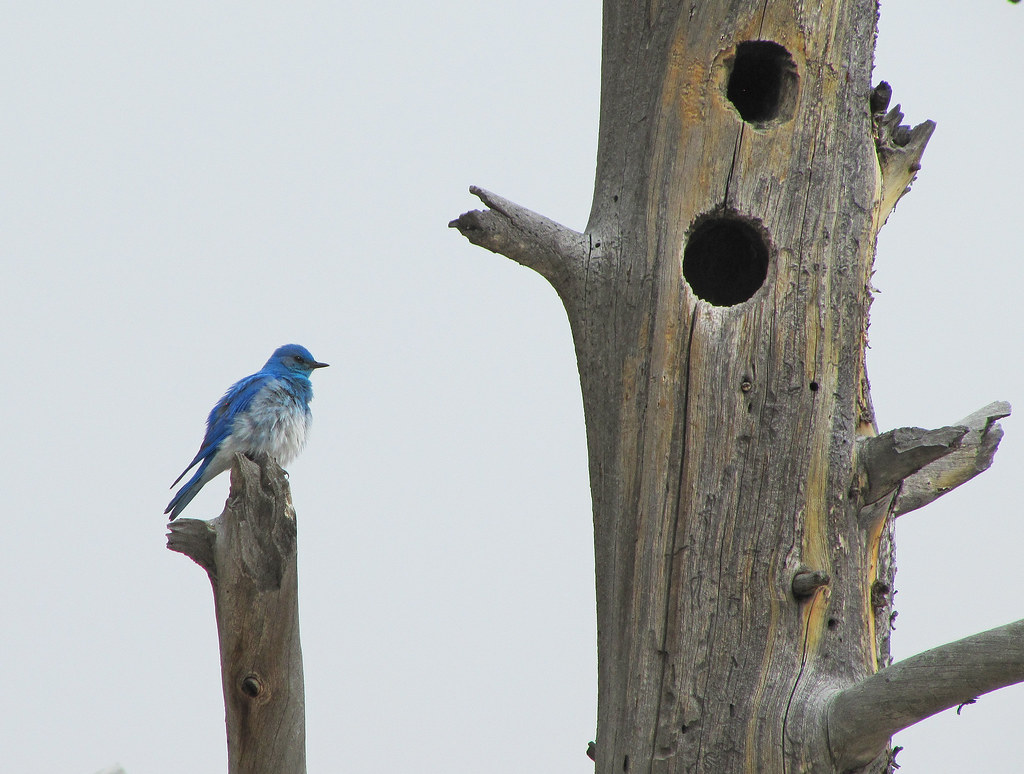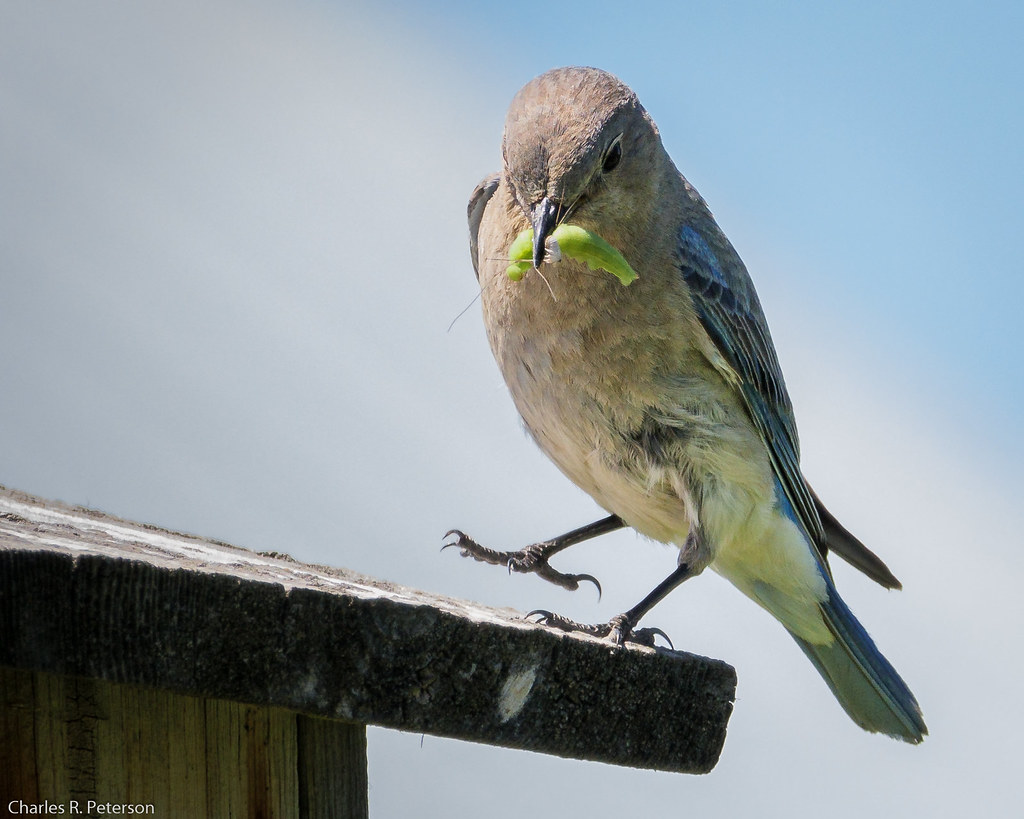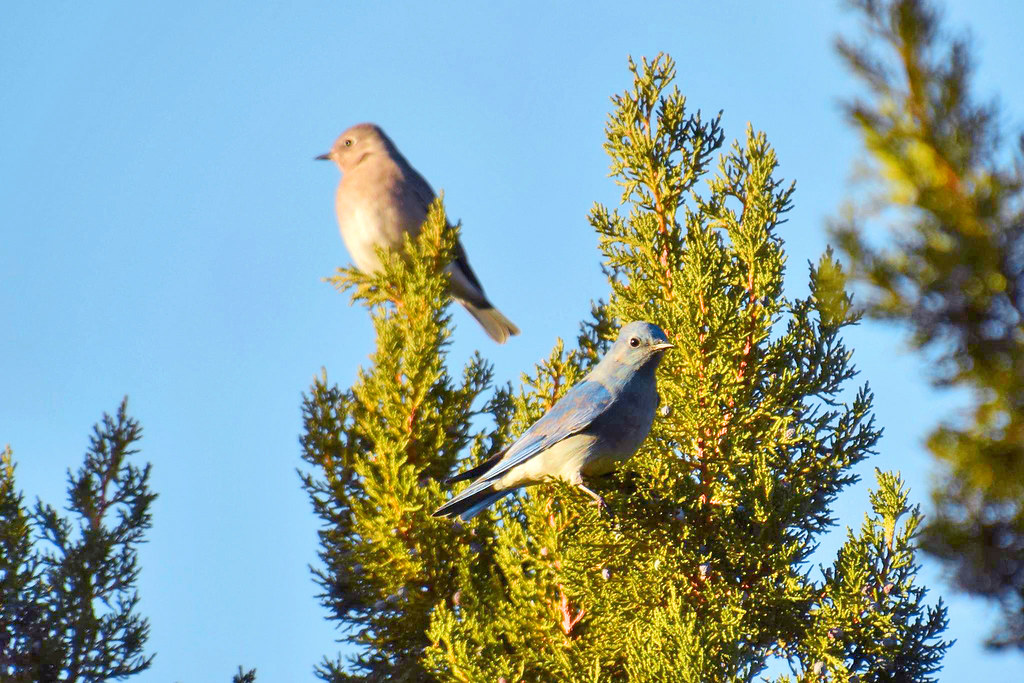
With a population of just around 4.6 million, Mountain Bluebirds are the least common bluebird species in North America. For a comparison, the more common Eastern Bluebird has a total population around 22 million! If you live east of the Rocky Mountains like me, you’ve probably never even seen a Mountain Bluebird.
So, I thought it would be fun to explore some facts about the bluest of all bluebirds. (Yes, the males are a gorgeous blue and white – no red markings at all.) Here are 21 fun facts about Mountain Bluebirds.
Photo above by Larry Lamsa is licensed under CC BY 2.0
1. Mountain Bluebirds are secondary-cavity nesters

Mountain Bluebirds are secondary cavity nesters, which means they build their nests inside old woodpecker holes or naturally occurring holes in trees. This makes them different than primary cavity nesters, like woodpeckers, who can excavate their own tree hole to nest in.
The fact that Mountain Bluebirds nest in cavities is great for birdwatchers, because we can attract them to our yards with bluebird nest boxes (bird houses). For the best nest boxes for Mountain Bluebirds, click to see my Recommended Tools page here.
2. Mountain Bluebirds “hover” while hunting

The Mountain Bluebird is the only species of bluebird that “hovers” to catch insects. When hunting, bluebirds typically sit on a low perch, like a tree or fence post, to keep an eye out for insects. When they spot one, they’ll swoop to the ground to catch it. This is the only way that Eastern and Western Bluebirds hunt.
Mountain Bluebirds are a little bit different. In addition to swooping to the ground to catch their prey, they also catch insects in mid air. Sometimes, when they spot an insect, they will hover over it, flapping their large, kestrel-like wings, to catch the insect in mid air. This hunting style definitely makes Mountain Bluebirds unique.
3. Mountain Bluebirds often nest inside natural cavities in Aspen trees

We love attracting bluebirds to our nest boxes so that we can watch them up close, but as far as natural cavities go, Mountain Bluebirds love to nest in Aspen trees.
Woodpeckers frequently drill holes in Aspens to build their own nests. So, since Aspens are common throughout Mountain Bluebird territory, it makes sense that Mountain Bluebirds often choose Aspens as their preferred nesting sites, to take advantage of unused woodpecker holes.
4. The male Mountain Bluebird looks for potential nesting sites, but the female makes the final call

When it comes to Mountain Bluebirds, the male scouts out different nesting locations, but the female is the one who makes the final decision. The female likely gets to make the final call because she is the one who actually builds the nest.
When a male Mountain Bluebird scouts out nesting sites, he will fly around the different nest boxes or natural cavities that he finds and attempt to catch the female’s attention. He’ll fly in and out of the entrance hole, showing the female that he’s found something that she should check out.
Then, the female will check out each potential nesting site after the male. When she finds one she likes, she’ll start building the nest while the male protects the territory and brings her food.
5. 92% of a Mountain Bluebird’s diet consists of insects and other bugs

Studies show that 92% of a mountain bluebird’s diet consists of insects and other bugs (source). Mountain Bluebirds, like the other species of bluebirds, are mainly insectivores, and they thrive on caterpillars, spiders, beetles, and crickets. Throughout the spring, summer, and early fall, Mountain Bluebirds eat mostly insects, but in the winter they will start eating fruit when insects becomes scarce.
6. Mountain Bluebirds have fewer broods-per-season than other bluebirds

The next on my list of 21 fun facts about Mountain Bluebirds is this: Mountain Bluebirds raise 1-2 broods per season, on average, whereas Eastern and Western Bluebirds typically produce 2-3 broods a year.
So, if you are trying to attract Mountain Bluebirds to a nest box in your yard, make sure you have it up by mid-February so that the bluebirds can find it early. If they find your nest box early enough, they might be convinced to raise their two broods per year in your yard!
Even though Mountain Bluebirds produce fewer broods a year than other bluebirds, they do tend to lay more eggs.
7. Mountain Bluebirds lay the most eggs-per-nest of all the bluebird species

Mountain Bluebirds lay more eggs per nest than either Eastern or Western Bluebirds. While Eastern and Western Bluebirds typically stop laying at a maximum of five eggs per nest, Mountain Bluebirds can lay up to eight eggs in a single nest.
The fact that they lay more eggs per nest is a good thing when you consider that Mountain Bluebirds usually raise fewer broods per season. Maybe this is their way of evening things out.
8. The Navajo people view Mountain Bluebirds as a symbol of the coming of spring

In Navajo culture, Mountain Bluebirds (and Western Bluebirds) are regarded as a symbol of the coming of spring. These birds are highly esteemed and are also thought to be a source of happiness. This makes sense, since bluebirds start looking for nesting sites in early spring, and who isn’t happier in the spring time?
9. The Mountain Bluebird used to be called the Arctic Bluebird

The Mountain Bluebird was originally named the Arctic Bluebird, according to the National Audubon Society (source). The species also went by the name “Ultramarine Blue-bird” due to its bright blue markings which distinguish it from Eastern and Western Bluebirds.
Eventually, Mountain Bluebirds became known by their current Latin name (Sialia currucoides) and joined the two other species of bluebirds in the genus Sialia, introduced by William John Swainson in 1827 (source). Since then, the official name “Mountain Bluebird” has stuck.
10. Mountain Bluebirds have the largest wingspan of any bluebird species

Mountain Bluebirds have a larger wingspan than other species of bluebirds – up to 14.2 inches for Mountain Bluebirds, 13.4 inches for Western Bluebirds, and only up to 12.6 inches for Eastern Bluebirds (source).
This is one of the main reasons that people consider Mountain Bluebirds to be the largest bluebird species. Interesting, they might not actually be the largest species. Here’s why.
11. Mountain Bluebirds can actually weigh less than Eastern Bluebirds

Even though Mountain Bluebirds require more space and have a larger wingspan than other bluebird species, they actually can weigh less, on average, than Eastern Bluebirds.
According to the Cornell Lab of Ornithology, Mountain Bluebirds can weigh up to 30 grams, whereas Eastern Bluebirds can weigh up to 32 grams (source). This might be surprising, since Mountain Bluebirds are usually thought to be the largest bluebird. But, as far as total weight goes, Mountain Bluebirds might actually be the smallest.
12. The Mountain Bluebird is the state bird of Idaho and Nevada

If you live in Idaho or Nevada, the Mountain Bluebird is your state bird! Overall, bluebirds have been chosen as state birds in four different US states. Eastern Bluebirds are the state birds of New York and Missouri, and Mountain Bluebirds hold the title of “state bird” in Idaho and Nevada.
13. The Mountain Bluebird population went up (and then went down) due to the logging industry

According to the Cornell Lab of Ornithology, the Mountain Bluebird population increased with the rise of the logging industry in the early 20th century, and then their population later decreased when the logging industry waned (source). So, why are Mountain Bluebirds so connected to logging?
Mountain Bluebirds thrive in open grassland where there is plenty of access to natural cavities where they can build their nests. When a forest is cleared, by either a wildfire or by logging, Mountain Bluebirds benefit from the open grassland and access to more dead trees for nesting cavities. Their population usually goes up due to logging and wildfires.
When logging was at its peak, Mountain Bluebirds seemed to do pretty well at finding natural cavities, and their population increased. However, the Mountain Bluebird population decreased by 24% from 1966 to 2015 (source). This decrease is generally attributed the suppression of wildfires in the American west and the decline of the logging industry.
Thankfully, things are now looking more predictable for Mountain Bluebirds:
More recently, as land-use practices have stabilized, so have Mountain Bluebird populations. Construction of nest boxes in suitable habitat has also provided a population boost.
Cornell Lab of Ornithology (source)
If you live in Mountain Bluebird territory, consider putting up a bluebird house to provide a stable nesting site for Mountain Bluebirds. Click here to read my article called 10 Steps to Become a Bluebird Landlord.
14. Female Mountain Bluebirds sometimes “beg” for their mates to feed them

It might sound strange, but sometimes, female Mountain Bluebirds beg for their mates to bring them food.
Male Mountain Bluebirds are usually the ones who take charge of finding food, especially when the female is busy incubating eggs or keeping her newborns warm. So, when the male brings back an insect to give to his mate, the female Mountain Bluebird will often “beg” for the insect, opening her beak like a fledgling and asking to be fed.
15. Mountain Bluebirds take care of their young for about a month after they leave the nest

Mountain Bluebirds will spend about 17-23 days in the nest after hatching, but apparently, they still have much to learn after that. Once Mountain Bluebird fledglings leave the nest, their parents still take care of them for 3-4 more weeks, teaching them how to fly and catch food (source).
You might spot adult Mountain Bluebirds with their young out and about during this time period. Juvenile Mountain Bluebirds can be recognized by their dull gray-blue wings and their white and black speckled bodies.
16. Mountain Bluebirds can travel in flocks of 30 or more

During the winter, Mountain Bluebirds are known to travel around in groups of 30 or more (source). While bluebirds usually stay in pairs throughout the nesting season, during the winter, it’s common to spot larger groups of Mountain Bluebirds travelling together.
You especially might see a group of bluebirds devouring the berries off of a fruit-bearing shrub or tree. Click here to read about 7 Plants that Attract Bluebirds.
If you live in an area where Mountain Bluebirds and Western Bluebirds overlap, the winter is also a time when you might spot these two species travelling together.
17. A group of Mountain Bluebirds is called a mutation

The English language has many unique ways of naming collective groups of animals – school of fish, a pride of lions, a heard of cattle. Bluebirds are no exception to this phenomenon. A collective group of Mountain Bluebirds is called referred to as a mutation.
Now, you will probably never hear anybody talking about bluebirds this way, but it’s a fun fact to know. Since bluebirds are a part of the “thrush” family of birds, and groups of thrushes are called mutations, a group of Mountain Bluebirds is also a mutation.
18. The Mountain Bluebird is the only species of bluebird to visit Alaska

Bluebirds are unique to North America, which is one of the reasons they are so beloved – because of their uniqueness to a particular region. Although all three species of bluebirds inhabit the entirety of the continental United States, Mountain Bluebirds are the only species to visit Alaska, and they don’t stick around for long when they visit.
Mountain Bluebirds will visit Alaska during the breeding season, when the are mobile and more likely to travel. But, by the time the nesting season comes around, they are more likely to stay farther south in Canada and the continental US.
19. Mountain Bluebirds Sometimes Interbreed with Eastern Bluebirds

While Mountain Bluebirds typically live at high elevations west of the Rocky Mountains, they do sometimes travel east. When their range begins to overlap with Eastern Bluebirds, sometimes Mountain Bluebirds pair up and interbreed with Eastern Bluebirds.
Eastern Bluebird and Mountain Bluebird interbreeding seems to be rare. It likely increases when bluebirds can’t find an available mate of their own species. But, since Eastern and Mountain Bluebirds are so similar, interbreeding does occur.
One female Mountain Bluebird even travelled as far east as Wisconsin to pair up with a male Eastern Bluebird in 2020. This was a state first for Wisconsin because Mountain Bluebirds rarely travel that far east. You can read more about this particular Wisconsin Eastern-Mountain Bluebird hybrid pair at ebird.org.
20. Mountain Bluebirds require more living space than other species of bluebirds

Mountain Bluebirds prefer larger nest boxes, and they defend a larger territory than Eastern and Western Bluebirds. While Eastern Bluebirds in particular show a preference for smaller nest boxes, with a floor of around 4×4″, Mountain Bluebirds prefer a larger nest box with a 5×5″ floor.
The Mountain Bluebird species also defends a larger territory than other bluebird species. While it’s fine to space Eastern Bluebird nest boxes just 100 yards apart, Mountain Bluebird nest boxes should be spaced 200-300 yards apart according to the North American Bluebird Society (source). They just like to have more space in their nest box and more space between themselves and their neighbors.
21. Some Mountain Bluebirds switch mates in the middle of breeding season

While Mountain Bluebirds are usually monogamous, they will sometimes switch partners in the middle of the season to raise a second brood (source). Partner-switching may happen after a failed nesting attempt in an effort to produce a successful brood. Since producing more offspring is the name of the game for Mountain Bluebirds, sometimes they do switch mates, just to be safe.
Conclusion
I hope you enjoyed this list of 21 fun facts about Mountain Bluebirds. If you want to attract Mountain Bluebirds to your own backyard, you’re at the right place! Click here to read my article called 10 Steps to Become a Bluebird Landlord. This will be the best place to get started.

